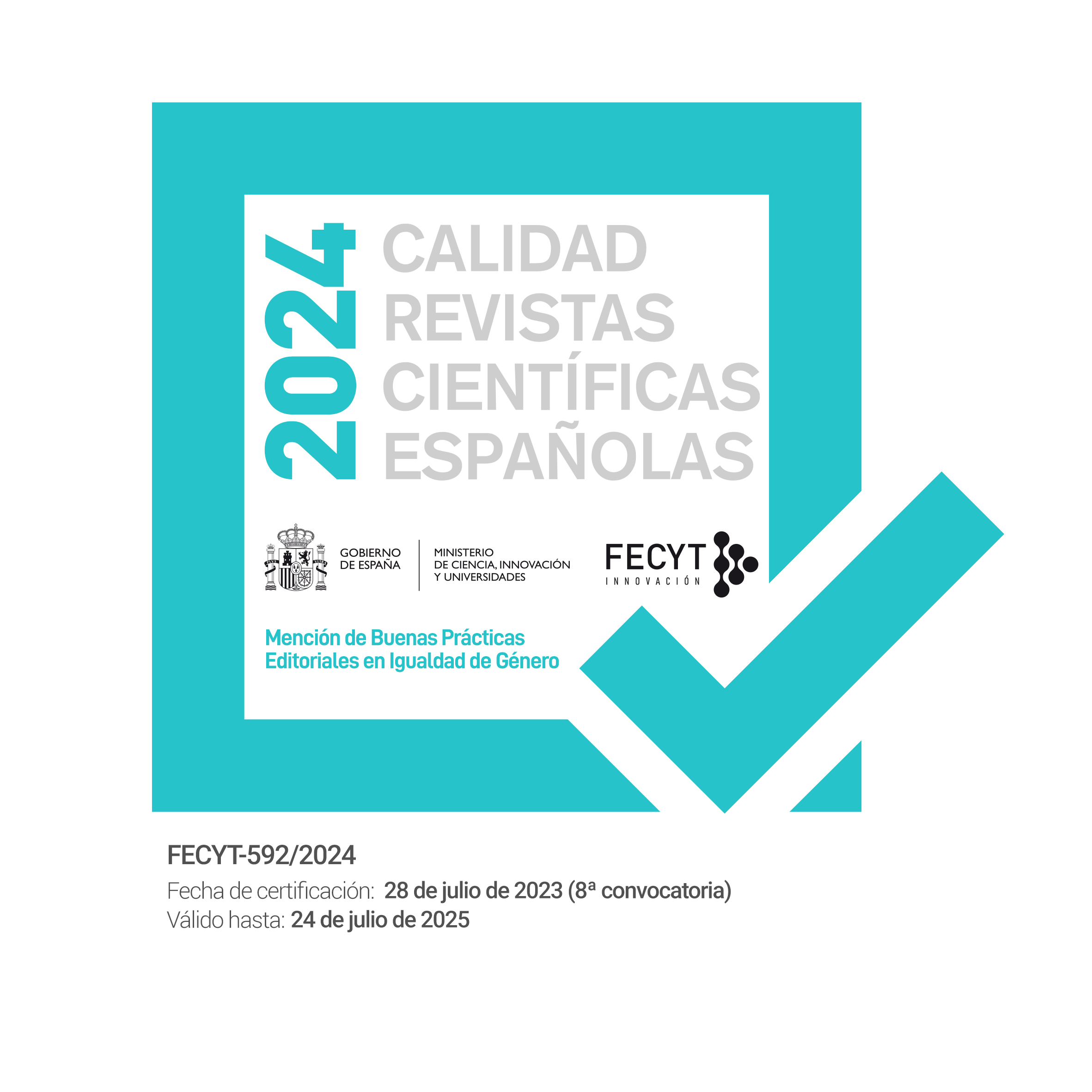The relevance of trafficking data. Trafficking statistics of victims in Spain under review
Abstract
Trafficking in Human Beings is a complex phenomenon, frequently biased by misconceptions about the definition and difficult to detect due to the underground nature of its activities. These circumstances obstruct the process of assesing the extent of the phenomenon in a country, affecting the decision-making process of anti-trafficking policies. The object of this article is to analyse the available data about trafficking in human beings in the case of Spain, including data provide by official sources and the dark figure approach. Following the analysis of the data the difficulties are exposed, regarding the content and the concept in the Spanish case. Conclusions present doubts about the existence of a data collection system of trafficking in human beings in Spain before 2015. Conclusions present/cast doubts about the very existence of a data collection system of trafficking in human beings in Spain until/before 2015.
Received: 12 June 2019
Accepted: 10 September 2019
Published online: 20 December 2019
Downloads
References
Acién, Estefanía y Checa, Francisco. 2011. “La actualidad del abordaje de la trata de personas para la prostitución forzada en España. El Plan Integral y sus implicaciones para trabajadoras del sexo inmigradas”, Gazeta de Antropología, 27 (1): 1-19.
Agustín, Laura. 2007. Sex at the margins, Londres: Zed Books.
Aronowitz, Alexis. 2009. Human Trafficking, Human Misery: The Global Trade in Human Beings, Westport, CT: Greenwood Press.
Bales, Kevin; Hesketh, Olivia y Silverman, Bernard. 2015. “Modern slavery in the UK: How many victims?”, Significance, 12 (3): 16-21.
Barret, Nicole. 2013. An Assessment of Sex Trafficking in Canada. Toronto: Canadian Women’s Foundation.
Bernstein, Elizabeth. 2010. “Militarized humanitarianism meets carceral feminism: The politics of sex, rights, and freedom in contemporary antitrafficking campaigns”, Journal of Women in Culture and Society, 36 (1): 45-71.
Brunner, Jessie. 2015. Inaccurate Numbers, Inadequate Policies: Enhancing Data to Evaluate the Prevalence of Human Trafficking in ASEAN. Hawai: East West Center.
Canappele, Stefano y Mancuso, Marina. 2013. “Are protection policies for human trafficking victims effective? An analysis of the Italian case”, European Journal on Criminal Policy and Research, 19 (3): 259-273.
Carchedi, F., Picciolini, A., Mottura, G. y Campani, G. (ed.). 2000. I colori della notte. Migrazioni, sfruttamento sessuale, esperienze di intervento sociale, Milán: FrancoAngeli.
Cho, Seo-Young. 2015. “Modeling for determinants of human trafficking: An empirical analysis”, Social Inclusion, 3 (1): 2-21.
Datta, Monti y Bales, Kevin. 2013. “Slavery in Europe: Part 1, Estimating the dark figure”, Human Rights Quarterly, 35: 817-829.
Davis, Kevin E.; Kingsbury, Benedict y Merry, Sally E. 2012. “Indicators as a technology of global governance”, Law & Society Review, 46 (1): 71-105.
Daunis, Alberto. 2015. “La nueva criminalización del proxenetismo”, Revista Penal, 36: 55-66.
Defensor del Pueblo. 2012. La trata de seres humanos en España: víctimas invisibles. Madrid: Defensor del Pueblo.
Dijk, Jan van. 2015. “Estimating human trafficking worldwide: a multi-mode strategy”. En Forum on Crime and Society, editado por Kristiina Kangaspunta, 1-15. Nueva York: Naciones Unidas.
Dijk, Jan van y Mierlo, Fanny K.-V. 2014. “Quantitative indices for anti-human trafficking policies: based on reports of the U.S. State Department and the Council of Europe”, Crime, Law and Social Change, 61 (2): 229-250.
Dijk, Jan van y Heijden, Peter. 2016. Multiple Systems Estimation for Estimating the Number of Victims of Human Trafficking across the World, Nueva York: Naciones Unidas.
Dodillet, Susanne. 2005. “Cultural Clash on Prostitution: Debates on Prostitution in Germany and Sweden in the 1990s”. En Genealogies of Identity: Interdisciplinary Readings on Sex and Sexuality, editado por Margaret Sönser Breen, y Fiona Peters, 39-56. Amsterdam: Rodopi.
Doezema, Jo. 2005. “Now you see her, how you don’t: Sex workers at the UN Trafficking Protocol Negotiation”, Social & Legal Studies, 14 (1): 61-89.
Doezema, Jo. 2002. “Who gets to choose? Coercion, consent and the UN Trafficking Protocol”, Gender and Development, 10 (1): 20-27.
Doezema, Jo. 2000. “Loose women or lost women? The re-emergence of the myth of «white slavery» in contemporary discourses of «trafficking in women»”, Gender Issues, 18 (1): 23-50.
Dottridge, Mike. 2003. Deserving trust. Issues of Accountability for Human Right NGOs, Ginebra: International Council on Human Rights Policy.
Eurostat. 2015. Trafficking in human beings. Luxemburgo: Unión Europea.
Fiscal General del Estado. 2014. Memoria. Madrid: Centro de Estudios Jurídicos. Ministerio de Justicia.
García Cuesta, Sara. 2012. “La trata en España: una interpretación de los Derechos Humanos en perspectiva de género”, Dilemata, 4 (10): 45-64.
Group of Experts on Action against Trafficking in Human Beings (GRETA). 2013. Report concerning the implementation of the Council of Europe Convention on Action against Trafficking in Human Beings by Spain. Estrasburgo: Consejo de Europa.
Gould, Amanda. 2010. “From pseudoscience to protoscience: Estimating human trafficking and modern forms of slavery”. Second Annual Interdisciplinary Conference on Human Trafficking, 1-64. Lincoln: University of Nebraska.
Gozdziak, Elzbieta y Bump, Micah. 2008. Data and Research on Human Trafficking: Bibliography of Research-Based Literature. Washington: Institute for the Study of International Migration, Georgetown University.
Heijden, Peter; Vries, Ieke; Böhning, Dankmar y Cryuff, Marten. 2015. “Estimating the size of hard-to-reach populations using capture-recapture methodology, with a discussion of the Internacional Labour Organization’s global estimate of forced labour”. En Forum on Crime and Society, editado por Kristiina Kangaspunta, 109-136. Nueva York: Naciones Unidas.
Iglesias, Agustina. 2011. “Género y derechos humanos: El control de las trabajadoras del sexo en el ámbito de las políticas contra la trata de mujeres con fines de explotación sexual”. En Dereitos Humanos e Países Emprobrecidos: Contradicións Nas Políticas de Cooperación Ao Desenvolvemento, dirigido por Baamonde Ferreiro, 65-83. A Coruña: Universidade da Coruña.
Juliano, Dolores. 2011. Presunción de inocencia: riesgo, delito y pecado en femenino. Guipúzcoa: Gakoa.
Kangaspunta, Kristiina. 2015. “Prefacio”. En Forum on Crime and Society, editado por Kristiina Kangaspunta, III-V. Nueva York: Naciones Unidas.
Kaye, Julie; Winterdyk, John y Quaterman, Lara. 2014. “Beyond criminal justice: A case study of responding to human trafficking in Canada”, Canadian Journal of Criminology and Criminal Justice, 56 (1): 23-48.
Kelley, Judith y Simmons, Beth. 2015. “Politics by number: Indicators as social pressure in international relations”, American Journal of Political Science, 59 (1): 55-70.
Laczko, Frank y Gramegna, Marco. 2003. “Developing better indicators of Human Trafficking”, Brown Journal of World Affairs, X (1): 179-194.
Lima de Pérez, Julie. 2015. “Examining trafficking statistics regarding Brazilian victims in Spain and Portugal”, Crime, Law and Social Change, 63 (3-4): 159-190.
Ministerio de Sanidad, Servicios Sociales e Igualdad. 2015. Plan integral de lucha contra la trata de mujeres y niñas con fines de explotación sexual, 2015-2018. Madrid: Gobierno de España.
Maqueda, M.ª Luisa. 2009. Prostitución, feminismos y derecho penal. Granada: Comares.
Maqueda, M.ª Luisa. 2002. El tráfico sexual de personas. Valencia: Tirant lo Blanch.
Mcgrogan, David. 2016. “The problem of casuality in International Human Rights Law”, International and Comparative Law Quarterly, 65(3): 615-44.
Merry, Sally E. 2016. The seductions of quantification. Measuring human rights, gender violence, and sex trafficking. Chicago: The University of Chicago Press.
Nelken, David. 2012. “La Trata de Seres Humanos y La Cultura Legal”, Anuario da Facultade de Dereito da Universidade da Coruña, 16: 615-646.
Nuño, Laura. 2017. “La Trata de Seres Humanos Con Fines de Explotación Sexual: Propuestas Para Un Cambio de Paradigma En La Orientación de Las Políticas Públicas”, UNED. Revista de Derecho Político, 98: 159-187.
Nussbaum, Martha. 2012. Crear capacidades. Propuestas para el desarrollo humano. Barcelona: Paidós.
Nye, Joseph. 2014. Soft power: The means to success in world politics. Nueva York: Public Affairs.
Oficina de las Naciones Unidas contra la Droga y el Delito (ONUDD). 2015. The concept of «exploitation» in the trafficking in persons protocol. Nueva York: Naciones Unidas.
Oficina de las Naciones Unidas contra la Droga y el Delito (ONUDD). 2014. The role of «consent» in the Trafficking in Persons Protocol. Nueva York: Naciones Unidas.
Oficina de las Naciones Unidas contra la Droga y el Delito (ONUDD). 2013. Abuse of a position of vulnerability and other «means» within the definition of trafficking in persons. Nueva York: Naciones Unidas.
Oficina de las Naciones Unidas contra la Droga y el Delito (ONUDD). 2010a. Manual on victimization surveys. Ginebra: Naciones Unidas.
Oficina de las Naciones Unidas contra la Droga y el Delito (ONUDD). 2010b. Report on the meeting of the Working Group on Trafficking in Persons held in Vienna from 27 to 29 January 2010 (CTOC/COP/WG.4/2010/6). Viena: Naciones Unidas.
Pomares, Esther. 2015. “Reforma del Código Penal Español en torno al delito de tráfico ilegal de migrantes como instrumento de lucha contra la inmigración ilegal en la Unión Europea”, Revista de Estudios Jurídicos UNESP, 19 (29): 1-20.
Requena, Laura; Giménez-Salinas Framis, Andrea y de Juan Espinosa, Manuel. 2012. “Estudiar la trata de personas. Problemas metodológicos y propuestas para su resolución”, Revista Electrónica de Ciencia Penal y Criminología, 14-13: 1-28.
Rubin, Gayle. 1989. “Reflexionando sobre el sexo: notas para una teoría radical de la secualidad”. En Placer y peligro. Explorando la sexualidad femenina, compilado por Carol S. Vance, 113-190. Madrid: Revolución.
Rubin, Gayle y Butler, Judith. 1994. “Sexual Traffic”, Differences: A Journal of Feminist Cultural Studies, 6.2+3: 62-99.
Saunders, Penelope. 2005. “Traffic violations: Determining the meaning of violence in sexual trafficking versus sex work”, Journal of Interpersonal Violence, 20 (3): 343-360.
Simmons, Beth; Lloyd, Paulette y Stewart, Brandon. 2018. “The global diffusion of law: Transnational crime and the case of human trafficking”, International Organization, 72 (2): 249-281.
Schönhöfer, Johanna. 2017. “Political determinants of efforts to protect victims of human trafficking”, Crime, Law and Social Change, 67 (2): 153-185.
Soderlund, Gretchen. 2005. “Running from the rescuers: New U.S. crusades against sex trafficking and the rhetoric of abolition”, NWSA Journal, 17 (3): 64-87.
Surtees, Rebecca y Craggs, Sarah. 2010. Beneath the Surface. Methodological Issues in Research and Data Collection with Assisted Trafficking Victims. Ginebra: IOM.
Tyldum, Guri; Tveit, Marianne y Brunovskis, Anette. 2005. Taking Stock. A Review of the Existing Research on Trafficking for Sexual Exploitation. Oslo: Fafo.
Villacampa, Carolina. 2015. “La trata de seres humanos tras la reforma del Código Penal de 2015”, Diario La Ley, 8554 (1): 1-18.
Villacampa, Carolina. 2012. “Políticas de criminalización de la prostitución: Análisis crítico de su fundamentación y resultados”, Revista de Derecho Penal y Criminología, 3 (7): 81-142.
Villacampa, Carolina y Torres, Núria. 2012. “Mujeres víctimas de trata en prisión en España”, Revista de Derecho Penal y Criminología, 8: 411-494.
Vries, Ieke y Dettemeijer-Vermeulen, Corinne. 2015. “Extremely wanted: human trafficking statistics - What to do with the hodgepodge of numbers?”. En Forum on Crime and Society, editado por Kristiina Kangaspunta, 15-36. Nueva York: Naciones Unidas.
Weitzer, Ronald. 2012. “Sex trafficking and the sex industry: The need for evidence-based theory and legislation”, Journal of Criminal Law & Criminology, 101 (4): 1337-1370.
Wise, Matthew y Schloenhardt, Andreas. 2014. “Counting shadows -measuring trafficking in persons in Australia”, International Journal of Criminology and Sociology, 3: 249-266.
Zhang, Sheldon; Spiller, Michael; Finch, Brian Karl y Qin, Yang. 2014. “Estimating labour trafficking among unauthorized migrant workers in San Diego”, The ANNALS of the American Academy of Political and Social Science, 653 (1): 65-86.
Deusto Journal of Human Rights / Revista Deusto de Derechos Humanos is an Open Access journal; which means that it is free for full and immediate access, reading, search, download, distribution, and reuse in any medium only for non-commercial purposes and in accordance with any applicable copyright legislation, without prior permission from the copyright holder (University of Deusto) or the author; provided the original work and publication source are properly cited (Issue number, year, pages and DOI if applicable) and any changes to the original are clearly indicated. Any other use of its content in any medium or format, now known or developed in the future, requires prior written permission of the copyright holder.



3.jpg)
3.jpg)
3.jpg)
.jpg)








